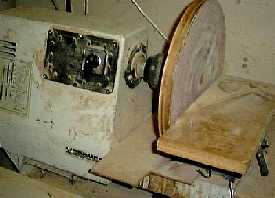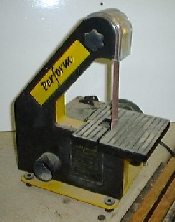A sanding disc
|
For those with a chuck with expanding jaws fixing a disc to their lathe is simple. All that is necessary is a flat disc of wood, plywood, chipboard or mdf, about ¾ inch (18 mm.) thick. The disc is mounted on a screw chuck (on the lathe) and the face and edge trued up. This is easier to do if the screw does not go right through the disk. The disk is then reversed on the screw chuck and the new face is trued up. Then a recess is formed to suit the chuck. When an abrasive disc is attached to the other side it is ready for use. When the discs are remounted it may be found that they don't always run true. This does not matter as long as the wobble is not too severe. For those without a chuck, a faceplate can be used to hold the disc but this is not so convenient. When a chuck is used a number of discs can be made up with different grits on the abrasive. Perhaps this is another reason to save up one's pennies for a chuck. What size should the disc be? I recommend the largest possible size up to a limit of 300 mm in diameter. The user could cut the circular abrasive discs from sheet material but it is much more convenient to buy them ready-made. I used to glue them onto the wooden disc with PVA glue but they are now available (in the UK) in a self-adhesive form with a peel off backing in a range of sizes and grits.
|
© Brian Clifford (November 2001)
 One of the most useful accessories in my workshop is a large sanding disc. It has many uses - these include sanding flat the base of goblets and cleaning up the end of spindle turnings where the waste has been parted off. This disc, which I have used for many years, is permanently attached to a spare lathe (see photo on the right). Not everyone will have the luxury of a spare lathe but it doesn't matter - a disc can be attached to your lathe as required with the aid of a proprietary chuck. Alternatively, those mechanically minded might be able to knock up a dedicated sander from an old motor and some bearings. Or, a small disc could be attached to a cheap grinding machine or an electric drill on a stand.
One of the most useful accessories in my workshop is a large sanding disc. It has many uses - these include sanding flat the base of goblets and cleaning up the end of spindle turnings where the waste has been parted off. This disc, which I have used for many years, is permanently attached to a spare lathe (see photo on the right). Not everyone will have the luxury of a spare lathe but it doesn't matter - a disc can be attached to your lathe as required with the aid of a proprietary chuck. Alternatively, those mechanically minded might be able to knock up a dedicated sander from an old motor and some bearings. Or, a small disc could be attached to a cheap grinding machine or an electric drill on a stand.
 Those with the money could, of course, go out and buy a dedicated sanding machine. These used to be very expensive but the price seems to have come down recently. The Perform brand (available in the UK) does a 300 mm disc sander with a 1 hp motor at what appears, on paper, to be a very reasonable price. A combined belt and disc sander could also be considered but I have found a disc (the one shown above) has satisfied my needs. However, I have recently purchased a small sander with a 25 mm belt (shown on right) for a very specific purpose (which I may reveal one day). In the absence of anything else it would, however, be very useful for cleaning up the ends of spindle turnings.
Those with the money could, of course, go out and buy a dedicated sanding machine. These used to be very expensive but the price seems to have come down recently. The Perform brand (available in the UK) does a 300 mm disc sander with a 1 hp motor at what appears, on paper, to be a very reasonable price. A combined belt and disc sander could also be considered but I have found a disc (the one shown above) has satisfied my needs. However, I have recently purchased a small sander with a 25 mm belt (shown on right) for a very specific purpose (which I may reveal one day). In the absence of anything else it would, however, be very useful for cleaning up the ends of spindle turnings.